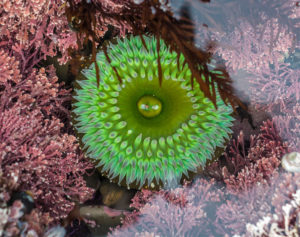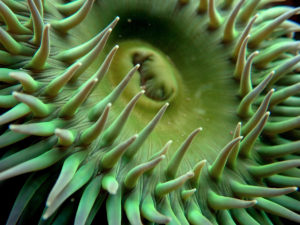Beaches are perhaps the most changeable of landscapes—some disappear entirely each year when winter storms crash against the coast. Hardly the place, it seems, to find clues about the distant past. But, with enough patience, that’s what you can find in the fossil sand dollars that wash up on local beaches.
At first glance, you might be tempted to lump sand dollars in with all the other “seashells”— the discarded armor of mussels, clams, and snails—that find their way onto most beaches. Not so fast, says Richard Mooi of the California Academy of Sciences. Mooi, a marine biologist who specializes in starfish and sea urchins, explains that sand dollar remains, called “tests,” are actually the skeletons (not the shells) of several species of flat sea urchins. In life, they are covered with very short spines, and the underlying hard structures of a sand dollar are covered with tissue. “The test is no more a shell than your skull is a shell,” he says.

The tests pictured here are of an extinct species, between 1 and 2 million years old, called Scutellaster interlineatus. Along the West Coast today, the most common sand dollar is Dendraster excentricus, distantly related to Scutellaster. The extinct and living West Coast sand dollars are two of just a few species, living or extinct, ever known to feed standing straight up and down, half-submerged in the sand, rather than lying prone. As the tide rolls in, they tip themselves up vertically to feed on microorganisms that drift by.

This particular adaptation is known to have evolved only three times, always along the western coast of North America; all other known sand dollars feed while lying flat on the ocean floor. “It’s a compelling statistic,” says Mooi, “and it makes you wonder about causality. It could be chance. It could be just a genetic propensity toward this in a larger group.” How do scientists know the feeding habits of a long-dead sand dollar? The clue is in the living Dendraster, the only living vertical feeder out of over 250 living species worldwide. Its mouth and respiratory parts are biased toward the back end, rather than centered. Fossils of sand dollars with similar anatomy—such as Scutellaster—likely fed in similar ways.
Fossil sand dollars can teach geology as well as sea urchin evolution. Scutellaster tests are commonly found in two places locally: onshore in the cliffs around Daly City and at the southern end of Point Reyes, near Stinson Beach. Both sites are most likely part of a single deposit that was split in two by the San Andreas Fault, with the western section carried northward on the Pacific Plate. Beaches, it turns out, are far from the only changeable landscapes in the restless topography of the Bay Area.
Special thanks to Kevin Scott for the use of his fossil collection and to JoAnn B. Brand for her calligraphy.




